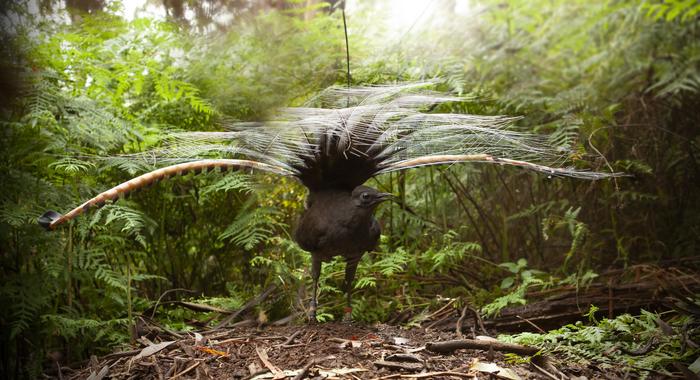
The superb lyrebird, a species native to Australia, is not just celebrated for its stunning plumage and exceptional mimicry but has recently been revealed to possess an unexpected yet remarkable skill: farming. This revelation, borne from innovative research led by scholars at La Trobe University, challenges long-standing notions about the ecological roles animals can play in their habitats. Researchers documented how the superb lyrebird creates microhabitats, cultivating environments that support a rich diversity of invertebrate prey such as worms, centipedes, and spiders, effectively displaying complex resource management behaviors.
Through detailed observations of these ground-dwelling birds, scientists noted their unique behavior in manipulating leaf litter and soil on the forest floor. By arranging these materials strategically, lyrebirds enhance their foraging success rates, effectively establishing conditions that are favorable for their dietary needs. These findings, published in the Journal of Animal Ecology, provide compelling evidence of the lyrebird’s role as an ecosystem engineer—a term used to describe species that fundamentally shape their environment and influence the distribution and abundance of other organisms in their ecosystem.
Conducting field experiments, researchers created lyrebird-free zones by temporarily fencing off certain areas from these birds. In these controlled settings, some plots underwent simulated foraging activities, where researchers raked the leaf litter and soil to mimic the natural processes initiated by lyrebirds. The result of this intervention was striking. In areas where raking mimicked the foraging habits of lyrebirds, a noticeable increase in the variety and size of invertebrate populations was observed compared to unfenced areas without such manipulations, underscoring the profound impact these birds exert on their ecosystems through their foraging habits.
Lead researcher Alex Maisey emphasized how such behaviors are relatively rare in the animal kingdom, further highlighting the lyrebird’s pioneering contributions to ecological dynamics. By provisioning their habitats with ample food resources, they effectively set the stage for an enriched environment ripe for their prey’s growth. This unique form of agricultural behavior suggests a level of environmental stewardship previously unrecognized in non-human species. Maisey’s research illustrates how these birds not only forage for immediate sustenance but also carefully curate their environments to ensure the ongoing availability of nutritious food.
The superb lyrebird, known scientifically as Menura novaehollandiae, typically thrives in the moist eucalyptus forests of southeastern Australia. It is in these lush settings that the lyrebird executes its complex foraging strategies, manipulating the ecosystem on a grand scale. Their activities significantly impact forest biodiversity, proving vital to the overall health of their habitats. By managing soil and litter, lyrebirds help reduce the combustible materials that fuel bushfires, thus playing an essential role in fire management and landscape conservation.
The study brings forth intriguing implications regarding the ecological significance of the superb lyrebird. As active agents within their ecosystems, they influence not just the flora and fauna surrounding them but also contribute substantially to ecological processes. During the research project, scientists found that a single lyrebird could move approximately 155 tonnes of litter and soil per hectare in its quest for food. This astonishing figure underscores the sheer scale of the effects these birds have on their environment, a testament to their role as nature’s unassuming cultivators.
Research in this domain not only enriches our understanding of lyrebirds but also poses a broader question about the relationships between species and their environments. The revelations surrounding the lyrebird’s behaviors may encourage a re-examination of other species traditionally viewed as merely consumers in their ecosystems. The nuanced foraging techniques showcased by lyrebirds challenge preconceived notions about the roles various species play, suggesting that many animals could have hidden talents as ecosystem engineers.
Moreover, these findings shed light on the intricate web of interactions that define healthy ecosystems. Understanding the ecological contributions from seemingly simple behaviors allows for a more profound appreciation of biodiversity and its preservation. This ongoing research can inform conservation efforts, demonstrating how protecting species like the lyrebird not only aids in their survival but also supports the broader ecological frameworks they inherently cultivate.
As researchers continue to explore the adaptive behaviors of the superb lyrebird, further studies may unveil additional layers to the ecological narratives surrounding these remarkable birds. The intersection of their foraging habits and their roles as ecosystem engineers expands the dialogue on conservation and habitat management, urging stakeholders to consider the cascading effects of species conservation on ecosystem health.
The narrative of the superb lyrebird exemplifies the complexities of ecological interdependence, where each species contributes uniquely to the fabric of its environment. As the research shows, the actions of this singular species ripple through the ecosystem, reinforcing the connectedness of all living beings within their habitats. This groundbreaking insight calls for a reconceptualization of our understanding of wildlife interactions and their impacts on biodiversity.
In conclusion, the remarkable findings regarding the superb lyrebird illustrate how the natural world is rife with untold stories of ingenuity and resourcefulness. The thorough investigation by La Trobe University researchers underscores the importance of recognizing the multifaceted roles that wildlife embody in ecological systems. By highlighting these contributions, we can foster a greater appreciation for biodiversity and cement the necessity for conservation efforts that honor the intricacies of the natural world.
Subject of Research: Animals
Article Title: Foraging activity by an ecosystem engineer, the superb lyrebird, ‘farms’ its invertebrate prey
News Publication Date: 5-Mar-2025
Web References: Journal of Animal Ecology
References: DOI: 10.1111/1365-2656.70009
Image Credits: La Trobe University
Keywords: Animal research, Forests, Australia, Environmental methods, Applied ecology, Agriculture
Tags: animal foraging success strategiesanimal mimicry and behaviorAustralian birds ecological rolesecological impact of birdsecosystem engineers in natureforest floor microhabitatsinvertebrate prey diversityJournal of Animal Ecology studiesLa Trobe University research findingslyrebird habitat manipulationresource management behaviors in animalssuperb lyrebird farming abilities






